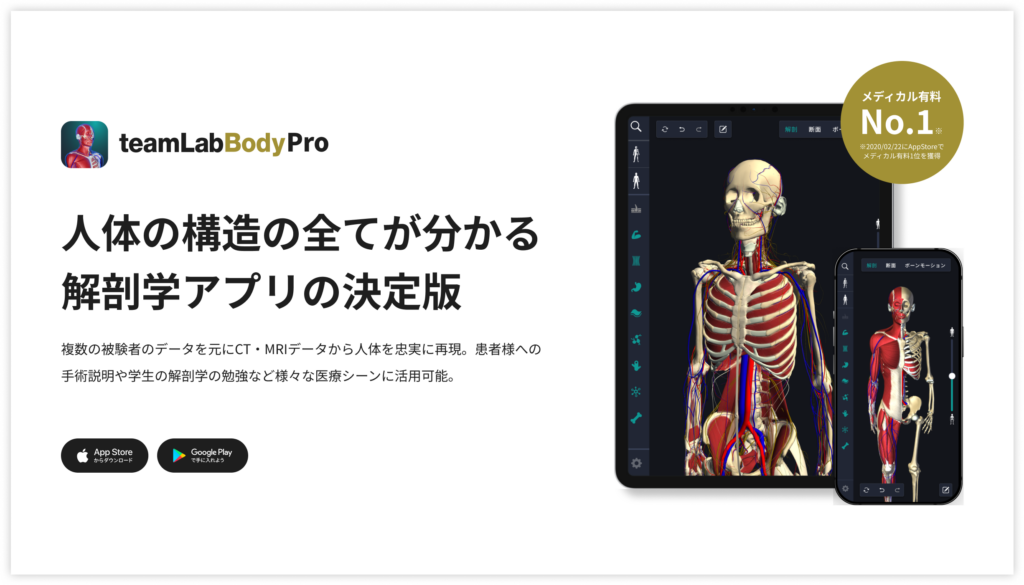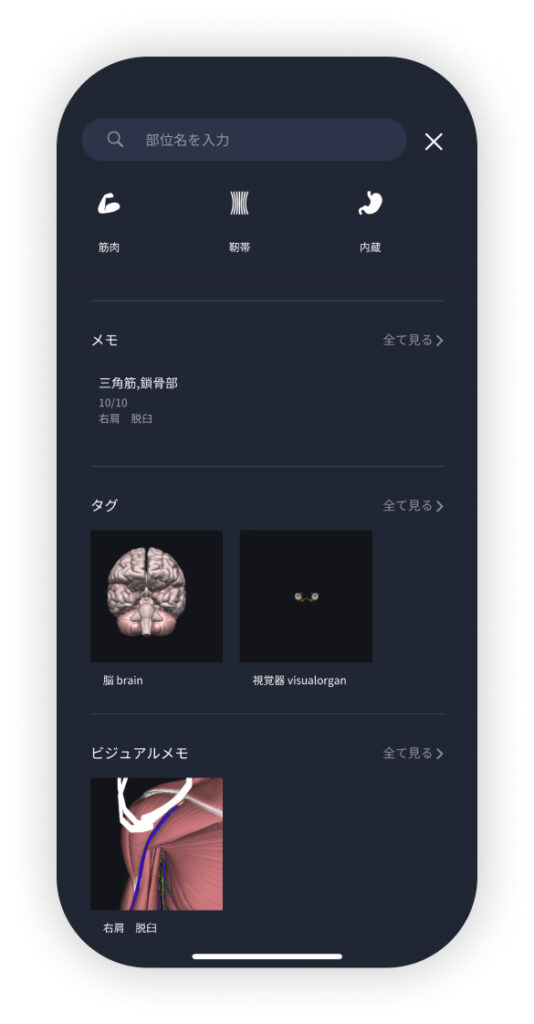beginning
In this article, I will explain effective study methods, starting with knowledge of specialized parts in human anatomy.
In human anatomy, it is necessary not only to memorize the names of various organs, muscles, and bones, but also to remember where they are located in the body. Therefore, it is necessary to learn as efficiently as possible.
I hope you will deepen your understanding even a little by reading this article and using the app.
Now, I will explain the details about the “transverse atlantal ligament” and how to study human anatomy.
teamLab Body Pro Free Download
A 3D anatomy app that shows all the structures of the human body
Download teamLab Body Pro here!

What is transverse atlantal ligament?
The anatomy application allows you to view a selection of anatomy 3D models. In this model, there are various observation methods such as surfaces, cross-sections, and nervous systems. This time, I'll explain using an anatomy application.
About transverse atlantal ligament

The transverse ligament of the atlas (transverse ligament of the atlas) is a ligament that connects the posterior tubercles inside the vertebrae (1st cervical vertebra) left and right, and has the function of holding the dental process (dens) firmly in front of it. The dentition of the axial vertebra (second cervical vertebra) exists in a form that pushes up the inside of the vertebral foramen of the annular vertebra, and by supporting it from the back, it prevents it from deviating forward and maintains the stability of the upper cervical vertebra.
This ligamentIt is part of the cruciform ligament (cruciform ligament) and is particularly the most important stabilizing ligament in the cervical spineIt is regarded as one of them. If this ligament is torn, the dental process moves backwards and there is a risk of directly compressing the spinal cord, which may lead to neurological disorders and life-threatening situations. In fact, atlantoaxial instability (atlantoaxial instability) in rheumatoid arthritis patients is mainly due to looseness or damage to this ligament.
Study points
Anatomical understanding: structure and location of transverse atlantal ligament
The transverse atlantal ligament is a strong ligament that runs so as to cross the inside of the atoll vertebrae (between the left and right medial lumps), and is located just behind the dental process. This ligament performs the function of fixing the dental process within the vertebral foramen and preventing contact with the spinal cord. In learning, it is important to understand the relative arrangement of denticles, annular vertebrae, and axial vertebrae three-dimensionally using a 3D application or a cross-sectional view of the annular joint. In particular, by simultaneously grasping the positional relationship with the upper and lower branches of the cruciate ligament, it is easier to organize complex ligament structures.
Functional understanding: role as a cornerstone of cervical spine stabilization
The transverse atresia ligament stabilizes rotational movement of the upper cervical spine by preventing the dentition from deviating backwards. Since this ligament functions properly, proper joint movement is maintained between the annular vertebrae and the axial vertebrae, and free rotation of the head is possible. When learning, it is effective to use a model to check how the tooth protrusion is supported from behind, and to imagine how stabilization is maintained during movement. By linking it experientially to “head rotation = support by ligaments,” retention in memory also increases.
Practical application: cases of damage due to rheumatoid arthritis and trauma
Clinically, transverse atlantal ligaments are attracting attention in evaluating atticular instability due to rheumatoid arthritis and high-energy trauma. When ligaments loosen, dental protrusions displace backwards, and spinal cord compression may cause quadriplegia and breathing problems. Deterioration in ligament function is indirectly assessed by measuring the distance between the tooth process and the anterior arch with MRI or X-rays (especially aperture x-rays). By being aware of “how dangerous damage is” to this ligament from when you were a student, it will be easier to understand the importance of clinical judgment.
How to study human anatomy
I will explain specific study methods using human anatomy applications.
Check your past learning history and practice repeatedly
Here are the steps to check your anatomy learning history and practice iteratively effectively.
1. Check your learning history in the app
Reviewing your learning history with the application is an important step in effectively advancing anatomy learning. First, launch the app and go to the learning history section from the main menu. Many anatomy apps are designed to show your progress in the form of graphs and lists, so you can visually check which parts you've learned about and how much time you've spent.
By using this data, you can understand which areas you have strengths in and where you need to spend more time and effort. We also recommend using a dedicated tag or notebook function to mark areas you are particularly weak at or where you need to relearn. Regularly checking your learning history and looking back on past learning content will lead to efficient review and deepening understanding.
2.Make a plan for iterative learning
Making an efficient repetitive learning plan based on learning history is extremely effective in promoting knowledge retention. First, identify weak points and areas where you need to relearn. Next, arrange these study items into a weekly or monthly calendar and create a specific study schedule. By proceeding in a planned manner, you can learn each part evenly and avoid packing in a large amount of information at once.
Using a task management app or digital calendar to set study reminders is effective. Also, it's important to have the flexibility to regularly review progress and revise plans as needed. By having goals and proceeding with your studies in a planned manner, you can efficiently acquire anatomical knowledge.
3.Use 3D features to learn visually
By utilizing the 3D function, learning anatomy is easier to understand visually. The 3D model shows the structure of the human body three-dimensionally, and each part can be observed in detail. This makes it possible to intuitively grasp positional relationships between deep muscles and organs that are difficult to capture in a planar view. For example, you can learn even the smallest details by rotating specific muscles and bones and zooming in and out.
Also, there are many apps that have the function of displaying cross-sectional views of each part using a 3D model, which is useful for deepening understanding of internal structures. This diversity of visual information helps with memory retention and improves immediate responsiveness in tests and practice situations. By utilizing the 3D function and learning visually, you can learn anatomy knowledge more deeply and efficiently.
Use the memo function concretely

Make notes so you don't forget the things and points you've noticed while studying. The memo function can be used for different purposes, such as inputting text, saving images, and writing memos. Tag your notes to make them easier to review later.
Test your learning regularly in the form of quizzes
Regularly testing what you've learned in a quiz format is a very effective way to anchor your anatomy knowledge. Quiz-style tests help you objectively grasp your level of understanding and areas you lack while repeating knowledge.
For example, by using a learning app to conduct quizzes every specific period, you can reconfirm what you've learned and strengthen your memory. There are a wide range of quiz formats, such as multiple choice questions, fill-in-the-blank questions, and short answer questions, and each helps understanding from a different angle and develops the ability to utilize various types of knowledge.
Get feedback
If possible, get feedback from other learners and experts. It helps you find your own gaps in understanding and areas for improvement. You can also keep yourself motivated to learn by regularly testing yourself. Feeling a sense of accomplishment and progress increases motivation for continuous learning.
summary
This time, I explained how to study “transverse atresia ligament” using an application!
Thank you for reading this far.
I would be happy if reading this article helped you learn about anatomy.
Learning is a long, never-ending journey, but I sincerely wish you all the best. Let's continue to study together and work hard for the national exam!
Please look forward to the next blog.
teamLab Body Pro Free Download
A 3D anatomy app that shows all the structures of the human body
Download teamLab Body Pro here!





